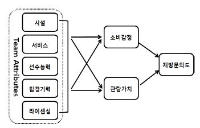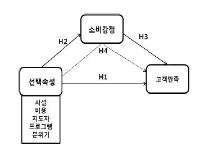
The purpose of this study was to provide managers and owners of Korea professional baseball teams with the necessary information for improving managerial performance by fan acquisition and retention. This paper chose LG, Nexen, and SK fans over the age of 17 as population of this study who visited at least twice home games held in the Jamsil, Mokdong, and Munhak baseball stadium. For the analysis of data, 413 questionnaires were used using SPSS 15.0 Windows and Amos 7.0. To examine respondents demographics traits, frequency analysis was processed and reliability analysis, confirmatory factor analysis and correlation analysis for relationship among the variables were conducted. Also, convergent validity analysis and discriminant validity analysis were made. Finally, path analysis was made for the verification of model suitability and of research hypotheses through structure equation modeling. The research results are as per the below. First, team attributes like physical facilities, team performance and licensing had significantly positive influence on consumption emotion. Second, team attributes like service and team performance significantly positive impact on viewing value. Third, consumption emotion had significantly positive impact on revisit intention. Fourth, viewing value had significantly positive impact on revisit intention.



The purpose of the study was to provide managers and owners of fitness center with new marketing strategies for distinction strategies of quite competitive Korean fitness industry with analysis of mediating effects of consumption emotion within the relationship of fitness selection attribute and customer satisfaction. This paper chose fitness center customers as population of this study who registered in each 5 fitness centers in Seoul and Gyeonggi using convenience sampling. For this study, 400 questionnaires were given fitness center customer. For the analysis of data, 376 questionnaires were used using SPSS 15.0 Windows and Amos 7.0. To examine respondents demographics traits, frequency analysis was processed and reliability analysis, confirmatory factor analysis and correlation analysis for relationship among the variables were conducted. For the verification of model suitability and research hypotheses, the mediating effects were tested by using Bootrapping method and Aroian-test through structure equation modeling. The significance level was set at α=.05, and the results are as follows. First, Among fitness selection attribute variables, structural strategy, cost, a trainer and program had significant influence on customer satisfaction, but, atmosphere and facilities had not significant on customer satisfaction. Second, Among fitness selection attribute variables, structural strategy, cost, a trainer and atmosphere had significant influence on consumption emotion, but, facilities and program had not significant on consumption emotion. Third, consumption emotion had significant influence on customer satisfaction. Fourth, consumption emotion fully mediated in the relationship between fitness selection attribute and customer satisfaction.


Purpose Sport has become a popular platform for corporate social responsibility (CSR) campaigns. Growing numbers of athletes, teams, and organizations are engaging in CSR campaigns to promote awareness and behaviors to support CSR campaigns addressing pressing social issues (e.g., disease prevention, health promotion, etc.). However, much of the previous work has focused on whether such initiatives benefit the organization, but not the community. The present paper provides theoretical explanations on the psychological mechanism that can demonstrate how consumers respond to CSR campaigns initiated by a sport organization. Method In particular, existing literatures in moral psychology and CSR have been reviewed to identify an explanatory mechanism that promote prosocial behavior among sport consumers. Results The present paper posits that moral emotion is a central processing mechanism explaining the link between CSR and socially responsible behaviors in consumers. The paper also provides a theoretical account to explain how moral emotions are evoked in the CSR context and how they can prompt prosocial behaviors. Conclusion This paper adds to the literature by answering the call for the need to understand underlying mechanisms linking CSR with positive social outcomes (cf. Aguinis & Glavas, 2012).